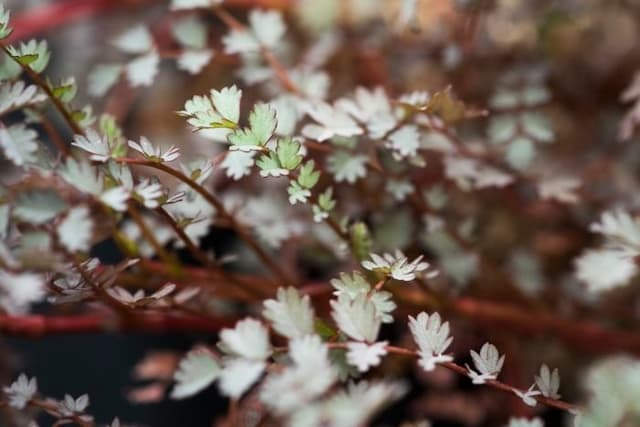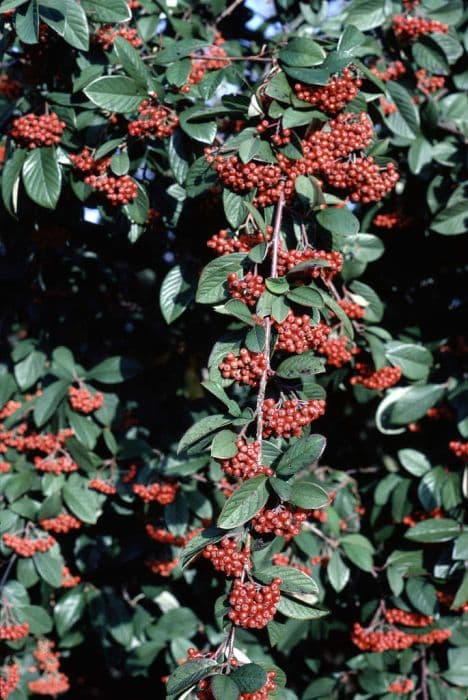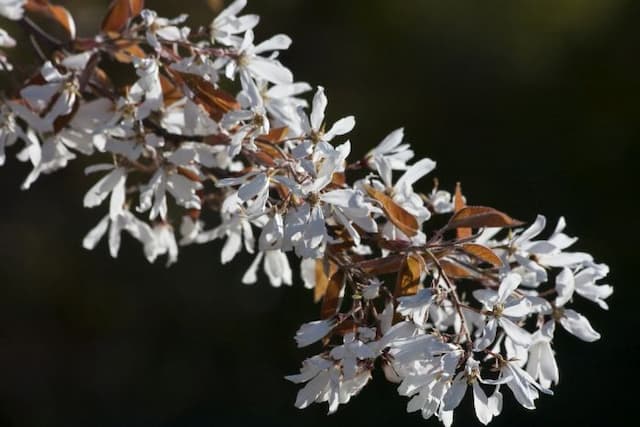Wild Strawberry Fragaria vesca (F)

ABOUT
Fragaria vesca, commonly known as the wild strawberry, is a perennial plant that produces slender, runner-like stems which enable it to spread across the ground. The leaves of this plant are trifoliate, meaning each leaf typically consists of three small, green, and toothed leaflets. These leaves are arranged in a rosette-like pattern at the base of the plant. Throughout the growing season, the wild strawberry blooms with small white flowers, each displaying five rounded petals surrounded by a collar of green sepals. The center of the flower consists of a cluster of yellow stamens. Following the flowering period, the plant bears its distinctive red fruit. The fruit is small and heart-shaped, dotted with tiny, embedded seeds on its surface. The texture of the fruit is somewhat soft, and it is known for its sweet taste and aromatic scent when ripe.
About this plant
 Names
NamesFamily
Rosaceae.
Synonyms
Wild Strawberry, Woodland Strawberry, European Strawberry, Alpine Strawberry, Carpathian Strawberry, Fraises Des Bois.
Common names
Fragaria bracteata, Fragaria collina, Fragaria communis, Fragaria elatior, Fragaria elliptica, Fragaria fragarioides, Fragaria glauca, Fragaria hirta, Fragaria monophylla, Fragaria muricata, Fragaria nigricans, Fragaria nilssoniana, Fragaria nipponica, Fragaria vesca var. americana, Fragaria vesca var. bracteata, Fragaria vesca var. californica, Fragaria vesca var. semperflorens, Fragaria vesca var. vesca.
 Toxicity
ToxicityTo humans
Fragaria vesca, commonly known as wild strawberry, is not considered toxic to humans. In fact, the fruit of the wild strawberry plant is edible and often enjoyed by many people. There are no common toxic effects associated with the ingestion of the wild strawberry by humans. However, some individuals may experience an allergic reaction if they are sensitive to this particular plant.
To pets
Fragaria vesca, commonly known as wild strawberry, is generally regarded as non-toxic to pets as well. Cats, dogs, and other domestic animals can typically consume wild strawberries without adverse effects. Nonetheless, just like in humans, some pets might have an allergic reaction or an individual sensitivity to the plant, but this is not common. It's always a good idea to introduce any new food to a pet in small amounts and monitor for any unusual reactions.
 Characteristics
CharacteristicsLife cycle
Perennials
Foliage type
Deciduous
Color of leaves
Green
Flower color
White
Height
0.5 feet (15 cm)
Spread
1 foot (30 cm)
Plant type
Herb
Hardiness zones
5
Native area
Temperate Northern Hemisphere
Benefits
 General Benefits
General Benefits- Edible Fruit: The fruit of Fragaria vesca, commonly known as wild strawberry, can be eaten fresh, used in jams, desserts, or as a natural flavoring agent.
- Ornamental Use: With its attractive foliage and small, white flowers, the wild strawberry can serve as a decorative ground cover or garden plant.
- Wildlife Habitat: The wild strawberry provides food for a variety of wildlife, including birds and small mammals.
- Eco-Friendly Lawn Alternative: The plant can be used as a low-maintenance and eco-friendly alternative to traditional grass lawns.
- Culinary Interest: Wild strawberries have a unique taste that is appreciated by chefs and gourmets, often used in high-end culinary dishes.
 Medical Properties
Medical Properties- Anti-inflammatory: Fragaria vesca has been used for its potential to reduce inflammation.
- Diuretic: Some cultures use the plant to promote urination, which can help in flushing out toxins from the body.
- Antioxidant: The berries are rich in antioxidants, which can scavenge harmful free radicals in the body.
- Skin health: Traditionally used to support skin health, possibly due to its vitamin content and astringent properties.
- Digestive aid: It has been used to aid digestion and as a remedy for gastrointestinal discomfort.
 Air-purifying Qualities
Air-purifying QualitiesThis plant is not specifically known for air purifying qualities.
 Other Uses
Other Uses- Fragaria vesca, commonly known as woodland strawberry, can be used in natural dyes; the leaves and roots create a variety of subtle green and beige tones on wool and textiles.
- The woodland strawberry can serve as a natural teeth whitener, as the seeds have mild abrasive properties that help to remove discoloration from the enamel.
- In gardens, the woodland strawberry is often planted for its attractive ground-covering foliage and bright red berries, enhancing the visual appeal of garden beds.
- Due to its lovely fragrance, Fragaria vesca is used in perfumery as a source of natural aroma, capturing the essence of wild strawberries.
- The fruit of woodland strawberry can be crushed and mixed with water as a mild natural cleanser for delicate fabrics, due to its gentle acidic nature.
- Woodland strawberry leaves can be infused in hot water to create a natural hair rinse that can impart shine and subtle highlights to the hair.
- The small flowers of Fragaria vesca can be used as edible decorations for pastries and desserts, adding a whimsical touch to gourmet dishes.
- When dried and pulverized, the fruit of woodland strawberry can be mixed with grain flours to add flavor and nutritional value to homemade breads and cakes.
- The woodland strawberry plants can be used in barren or eroded areas, as their runners and rooting system help to stabilize soil and prevent erosion.
- Fragaria vesca can be employed in companion planting to attract beneficial insects to gardens, which can aid in pollination and pest control for a variety of other crops.
Interesting Facts
 Feng Shui
Feng ShuiThe Wild Strawberry is not used in Feng Shui practice.
 Zodiac Sign Compitability
Zodiac Sign CompitabilityThe Wild Strawberry is not used in astrology practice.
 Plant Symbolism
Plant Symbolism- Innocence: The wild strawberry is often associated with innocence due to its small size and delicate nature, evoking feelings of purity and simplicity.
- Purity: Its bright red color and clean flavor give it an association with purity, making it a symbol of righteousness and virtue.
- Love and Passion: The heart-shaped berries have made wild strawberries a symbol of love and passion, representing romantic attraction and affection.
- Fertility: Wild strawberries are also symbolic of fertility due to their abundant seeds, representing potential for growth and new beginnings.
- Perfect Goodness: In medieval times, the wild strawberry was a symbol of perfect goodness, representing the good fruits of righteous living and perfect alignment with one’s values.
- Healing: Historically, strawberries have been used for medicinal purposes, symbolizing healing and the curative powers of nature.
 Water
WaterWild strawberries should be watered deeply enough to moisten the soil, which usually requires about 1 inch of water per week. The frequency of watering depends on temperature and soil conditions, but generally, they need more water during the warmer months and less during cooler months or when rainfall is sufficient. It’s important to keep the soil moist but not waterlogged, as standing water can lead to root rot. Water the plants using either a drip system or a soaker hose to keep the leaves dry and prevent fungal diseases. During extended dry periods, additional watering may be necessary.
 Light
LightWild strawberries, also known as alpine strawberries, perform best in full sun to partial shade. They need at least six hours of sunlight each day but can benefit from some afternoon shade in extremely hot climates. The best spot for planting them would be an area that receives morning sunlight and some protection from the intense heat of the afternoon sun.
 Temperature
TemperatureAlpine strawberries thrive in a temperature range of 60°F to 80°F, which is ideal for their growth and fruit production. They can survive temperatures down to 20°F and can tolerate up to 90°F, although extreme temperatures may stress the plants. Providing mulch can help regulate soil temperature and protect the roots from temperature extremes.
 Pruning
PruningPruning alpine strawberries is necessary to remove dead or diseased leaves and to encourage the growth of runners for new plants. Prune in late fall or early spring before new growth begins. Regularly removing old or damaged leaves throughout the growing season can also help maintain plant health. The best time for pruning is after fruiting has finished.
 Soil
SoilThe woodland strawberry, or Fragaria vesca, prefers well-draining soil rich in organic matter with a slightly acidic to neutral pH of 5.5 to 7. A mix of one-third peat, one-third sand, and one-third loamy soil is ideal for good root growth and drainage.
 Repotting
RepottingWoodland strawberries should be repotted every 1-2 years to refresh the soil and accommodate root growth. Larger planters are needed as the stolons spread and form new plants.
 Humidity & Misting
Humidity & MistingThe woodland strawberry thrives in moderate humidity levels, ideally between 40-60%. Avoid conditions that are too dry or excessively humid to maintain healthy growth.
 Suitable locations
Suitable locationsIndoor
Use well-draining soil, bright indirect light, allow runners.
Outdoor
Plant in rich soil, morning sun, water regularly.
Hardiness zone
4-9 USDA.
 Life cycle
Life cycleFragaria vesca, commonly known as wild strawberry, begins its life cycle as a seed that germinates in spring when the soil warms up. Seedlings emerge with their first true leaves and establish a small rosette by developing a few leaflets on each leaf. As the plants mature, they produce runners (stolons) which spread out and can take root to form new plantlets, thus colonizing the area. Flowering occurs in late spring to early summer, with small white flowers that have five petals and yellow centers. After pollination, typically by bees, the flowers develop into small red strawberries, which contain seeds on their outer surface, ready for dispersal by animals or other means. In the fall, wild strawberry plants prepare for winter dormancy by conserving resources, but they are perennial and will regrow from the same roots and crown the following spring.
 Propogation
PropogationPropogation time
Spring to Summer
The most popular method for propagating Fragaria vesca, commonly known as wild strawberry or alpine strawberry, is through runner division. This process generally occurs in the late summer after the plant has finished fruiting. The wild strawberry produces runners, which are long, horizontal stems that grow outward from the main plant. Along these runners, at various points, small plantlets form. Once these plantlets have developed their own roots, they can be gently separated from the mother plant and transplanted into a well-prepared soil mix. It's essential to keep the newly transplanted plantlets watered to ensure they establish themselves firmly in their new location. This straightforward method of vegetative reproduction helps gardeners to rapidly increase their strawberry patches without the need for buying new plants.









